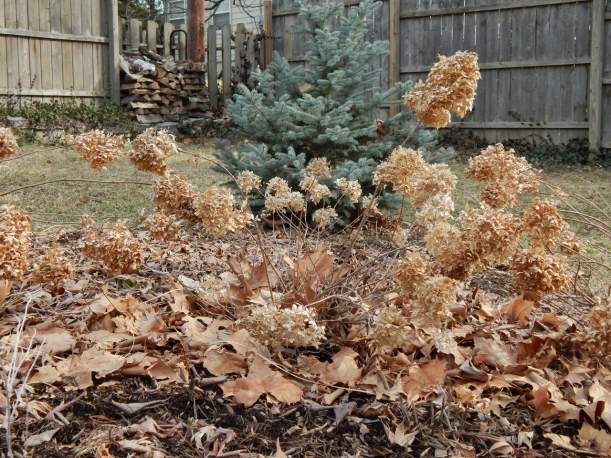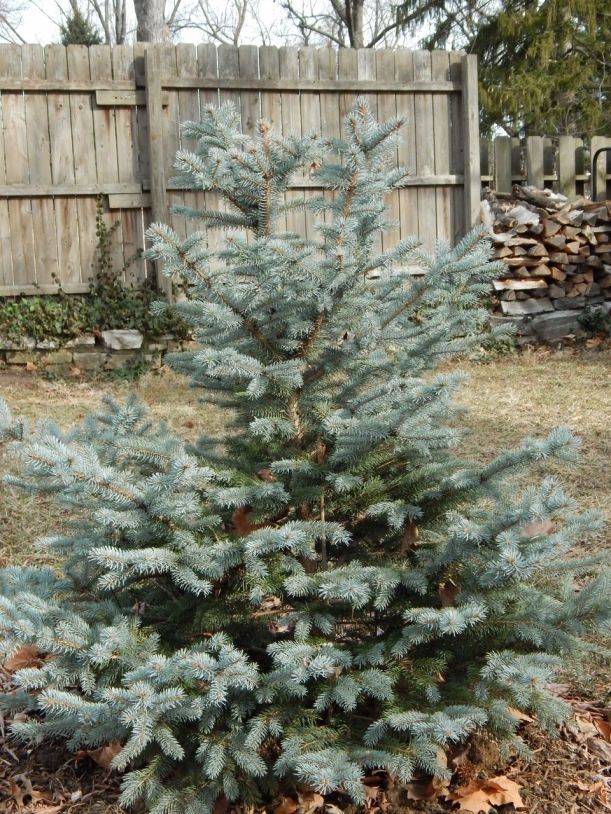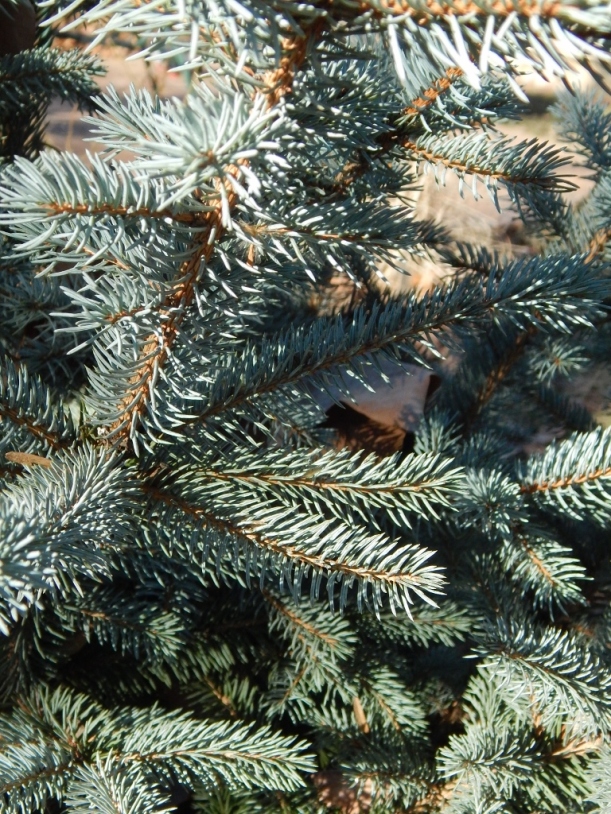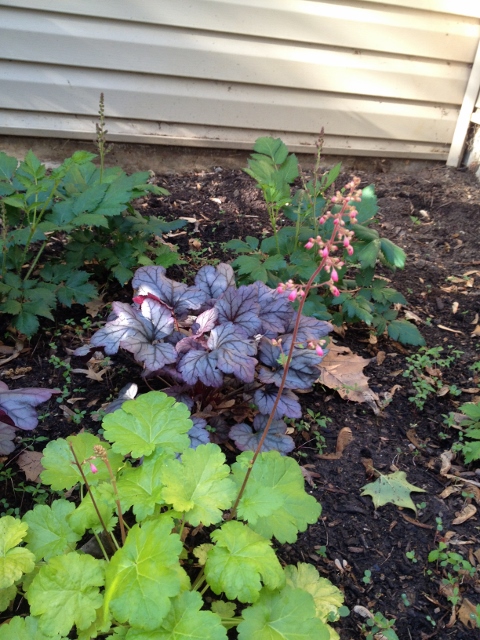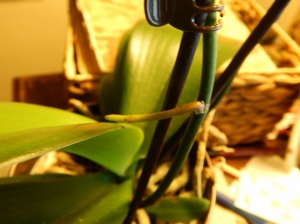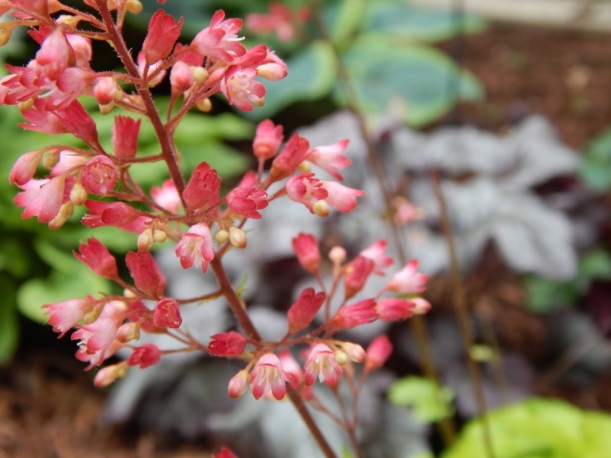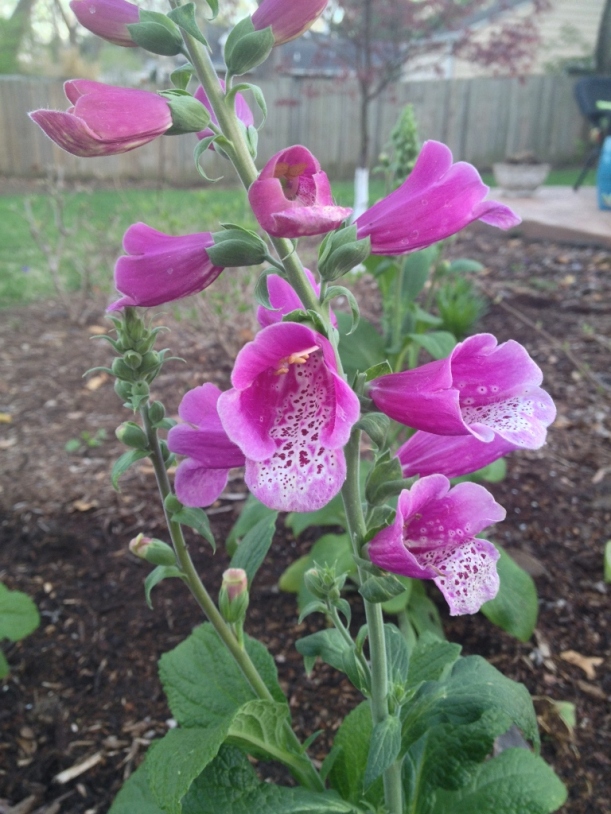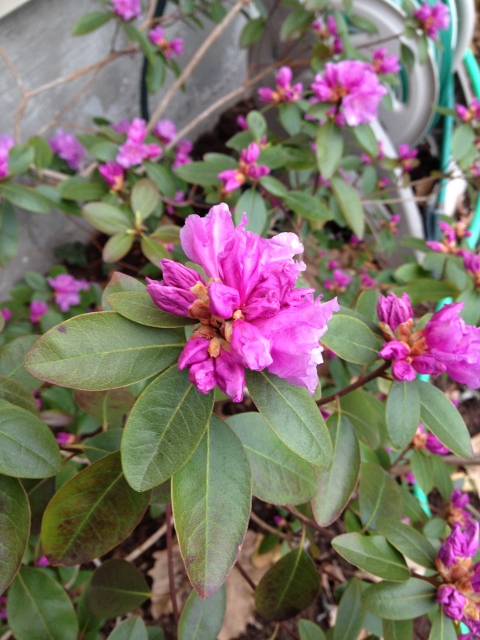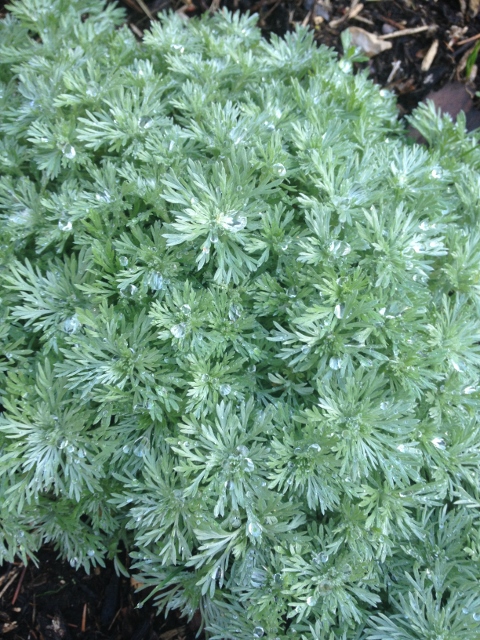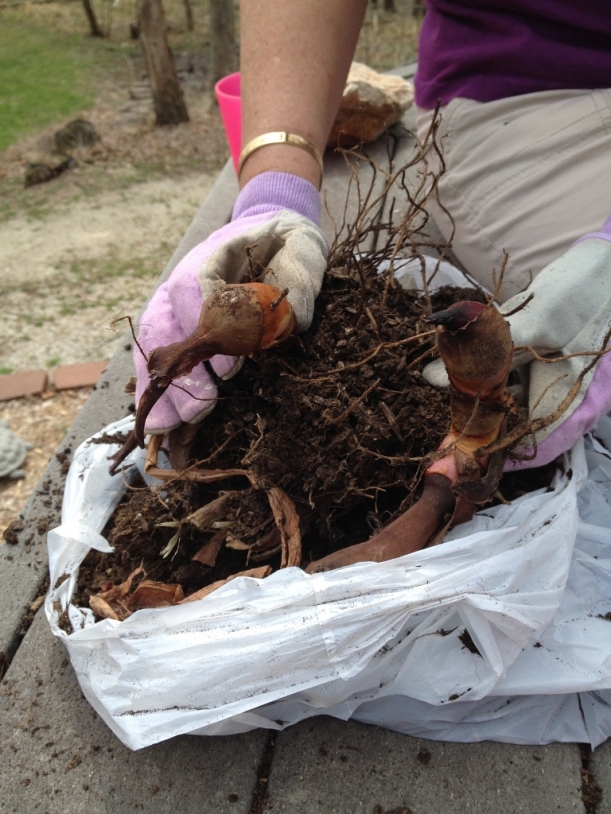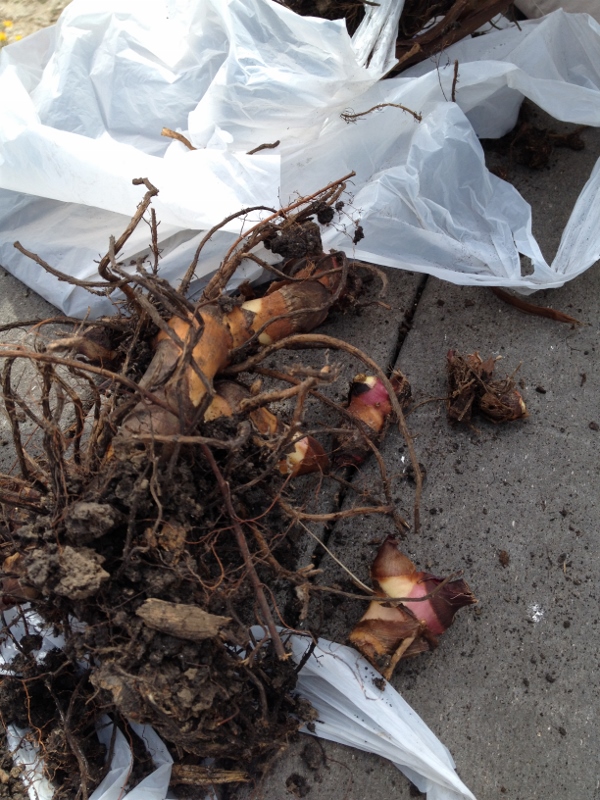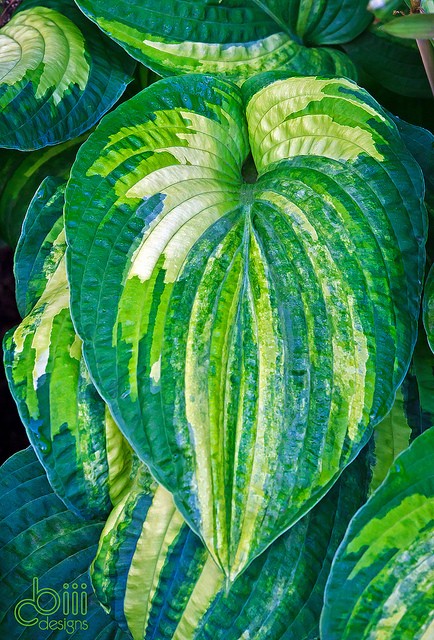Category Archives: Plants
Wordless Wednesday: Remains of the Day
Great Pairings for Shade
There’s no denying a dynamic combination when we see one. John, Paul, George and Ringo; tomato, mozzarella and basil; red wine and chocolate are three that come quickly to mind. As planning for the new shade bed along the south fence takes on more mental bandwidth, I’m focusing on great combinations that incorporate texture, shape, color and proportion. It can be enough to make my head spin, especially since I have had limited success in the deep shade areas of the yard.
To date my focus has been mostly on the sunny combinations I have been able to put together. Pots provide an inexpensive way to experiment with combinations. Each year I try and experiment with different textural and color combinations, keeping in mind the “filling, thrilling, spilling” trinity. And I have a sunny spot in the yard that I affectionately refer to as my “experimental bed.” There I have introduced all kinds of specimens that I have later moved to other sunny beds.
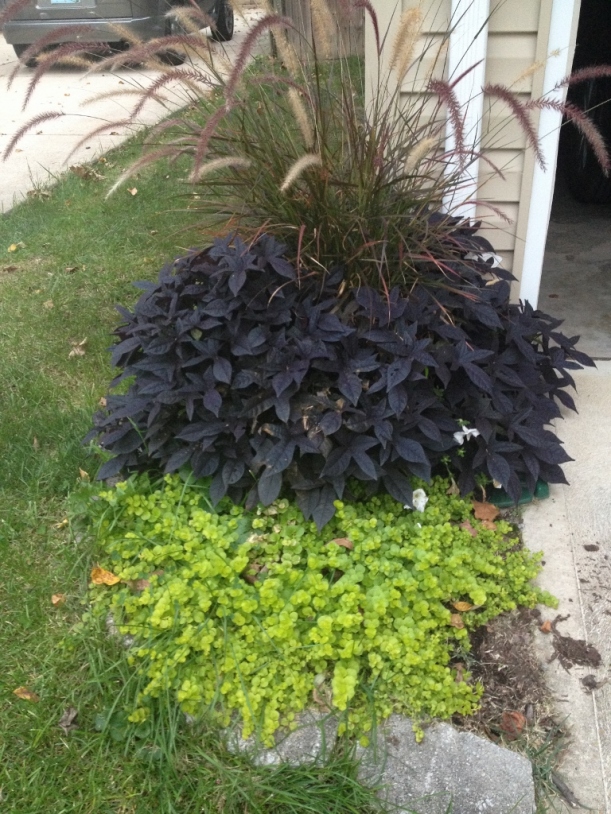
This pot of purple fountain grass, sweet potato vine and creeping jenny help screen the gutter by the front of the garage.

Yellow and orange dazzle during the hottest time of the day. The coreopsis, which thrives in this spot, got its start in the so-called “experimental bed.”
And while these combinations have been fun and lively, they won’t do for the shade. I began experimenting under the tree by the south fence last summer by planting two types of fern, hosta and astilbe. I may have planted one of the ferns (sensitive fern [Onoclea sensibilis]) too deep as it did not perform well; the astilbe withered, and the hosta tried to hang on for dear life but looked pathetic. I will wait to see if the ostrich fern (Matteuccia struthiopteris) reappears and plan to move it to the other end of the bed and plant a variegated solomon seal (Polygonatum) beneath the tree instead.
This is a long runway of fence to fill (about 28 feet) and I want something tall in the center. That’s where part of my angst comes in. What to plant? What to plant? A hydrangea of some sort? I have hydrangeas in two beds and love them but I want to branch out and try something new. I envision white caladium running along the length of the bed, filled in with hakonechloa grasses to brighten the shady spot. Other contenders include astilbe, large hosta, heuchera and brunnera. None of these meet the height requirement I am seeking. Any ideas, fellow gardeners? I am considering a vine or a small tree to put in the center of the bed to provide vertical interest.
If indecision gets the best of me this year, I will resort to moving a tall concrete plant stand and placing a lovely pot on top, keeping in mind the successful combination “filling, thrilling and spilling.” As always, thanks for reading.
Trying to Grow Orchids
 I’m fairly excited. I truly am. I came in from my dark, 10 degree F (-12 C) work commute to discover one of my orchids seems to be growing! There are new leaves and “shoots” (for lack of a better word) coming off the stems. Could this plant actually be–dare I say it–thriving?
I’m fairly excited. I truly am. I came in from my dark, 10 degree F (-12 C) work commute to discover one of my orchids seems to be growing! There are new leaves and “shoots” (for lack of a better word) coming off the stems. Could this plant actually be–dare I say it–thriving?
I find the world of houseplants to be more frustrating than my garden. Mostly it’s because I have limited space for them. But I enjoy the green beauty of a houseplant, especially in winter. I have two orchids, both from the grocery store, that were given to me as gifts. I believe they are Phalaenopsis or “moth orchids.” My first orchid was given to me two years ago at Christmas, and, it’s not doing the greatest (more on that in a minute). My performing orchid was given to me in August; both were in glorious bloom when I received them. Of course, I watched, misted, fed and fretted what I should do when the blooms die. Do I cut the stems down? The instructions on both tags told me to give the orchid 3 ice cubes a week. And to give it plenty of light. Check. Check. No problem following those simple instructions.
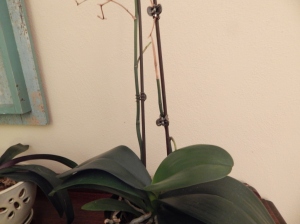
The browning stem makes me nervous? Do I cut this completely down? Trim it as it browns? Leave it alone? This time I opted to leave it alone.
But I do get nervous once the blooms fade and fall off. That’s because the stems begin to turn brown from the top down. Yikes, do I cut that off? Just trip off the dead stuff down to the nodule on the stem? Well, on the first plant I cut the stems when they completely turned brown and looked dead. I figured the plant would grow new stems. Hmmmmm, not so much.
So when plant #2’s blooms faded and fell, I repeated the same step. Only this time, the stems are not completely brown and growth is coming off the nodules of the stem. And–yes, there’s more good news here–there is new leaf growth. Truthfully, that does not excite me nearly as much as the stem growth because Orchid #1 had lots and lots of leaf and root growth after the stems died. In fact, it had so much leaf and root growth that I re-potted it after I had it more than a year and it seemed rather apparent that it was not going to rebloom. I thought that perhaps the thing was root bound.

Orchid #1 doesn’t seem so happy, even though I have treated it the same way as its sibling orchid. What gives?
I went to one of my favorite nurseries, bought a pot and planting material. I already had the orchid food, and the ice cubes. But I got nothing; the poor thing has not performed.
Maybe sibling rivalry will kick in and will start doing something, lest it be shown up by its younger sister.
A Closer Look at What’s Coming Up in the Garden
Here’s a close up of what’s blooming and coming up in my yard. I took these photos over the weekend, before we were hit with high winds and lots of rain.
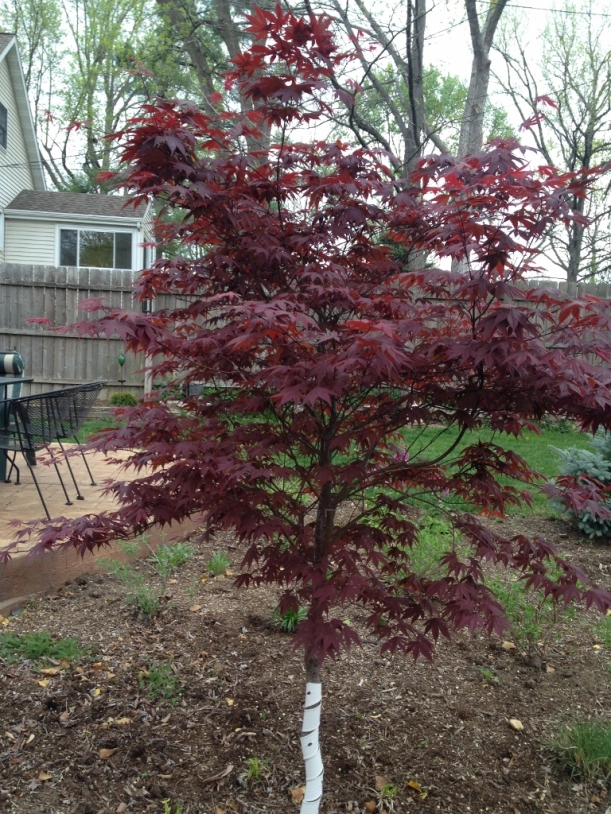
Bloodgood Japanese Maple was the centerpiece of my gardens and the first specimen I planted in 2012. In fact, it was the first tree I had ever planted. During spring the leaves seem to change color daily.
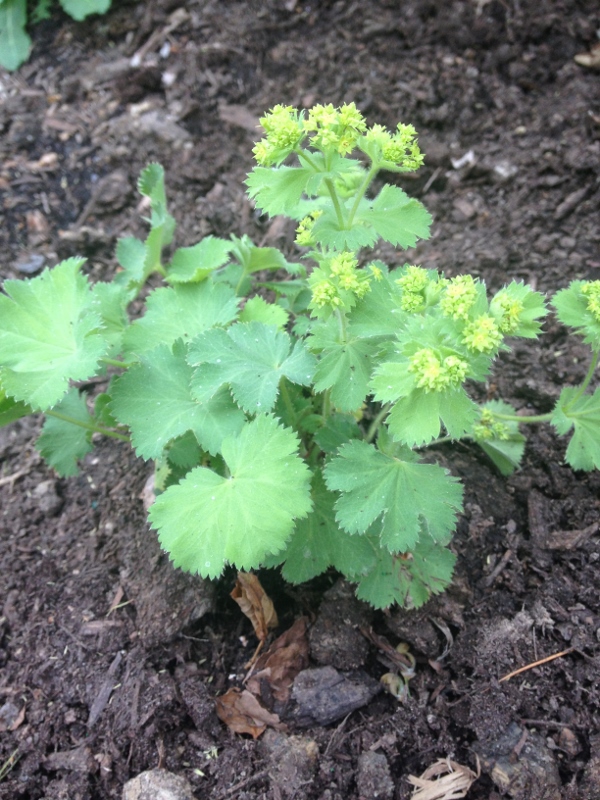
I can’t wait to watch one of the new additions to the garden–lady’s mantle. This is one of the plants I am obsessed with this year.

I am glad to see this shrub blooming. I see azaleas all over St. Louis and really like them, but have a hard time growing them. I plan to move my azaleas to a new location this fall in the hopes that a new spot will be better

I moved my Frances William hostas because they were getting too much sun. The new spot has morning sun and afternoon shade. I love the way this plant unfolds as it comes out of the ground
In the Garden: What a Difference a Month Makes
Life in the backyard is abuzz with growth! Just one month ago, perennials were just beginning to push their way through the soil. Take a look and see for yourself the plant progress in my St. Louis garden.

This bed beneath the family room window and bordering the patio, looked rather barren on March 29. The small bit of green is Meadow Sage.
I had yet to trim back the roses and still need to add mulch. There are four KnockOut rose shrubs in this bed, three of them planted last year. This bed faces east and gets lots of morning sun as well as sun from the south.

Mother Nature is not the only one who has been busy. I have added the rocks to better direct the drainage from the downspout, cleaned out the bed and trimmed the roses. I have added a few plants as well, although the vast majority are perennials planted over the past three years.
This is one of my favorite beds. Everything I have put in this bed has been happy, happy, happy as Phil would say on Duck Dynasty. In addition to the roses and Mianacht salvia (salvia x sylvestris), there are Cranesbill Biokova Karmina (geranium x cantabrigiense) which edge the bed. These mounding plants have wonderful year round interest, their leaves turning deep green to crimson red in the fall and winter. In early summer they are filled with small rose-hued flowers. Filling in the bed are Shasta daisy(Leucanthemum × superbum), variegated lily turf (liriope muscari), threadleaf coreopsis and new this season, Lady’s Mantle (Alchemilla mollis). I added the lady’s mantle to the north end of the bed, near the door, to bring some yellow to that end of things. I also transplanted a small and struggling shasta that had been in a bed near the fence. Anchoring the bed near the rocks on the south end is a low-to-the ground, creeping juniper (Juniperis horizontalis). This evergreen has lots of yellow in, which complements the hot pink of the roses and brightens the deep purple of the salvia.
I also like this bed because it wraps around to the south, which gets gobs of sun. It begins its southern turn where the Russian Sage (Perovskia atriplicifolia) is anchored. I added two Stella D’Oro lilies(Hemerocallis) to play off the color in the juniper and contrast with the cool lavender of the Russian Sage. This small grouping is a nice segue to the south-facing part of the bed. I’ll share more of that in another post.
How’s your garden growing?
Crazy for Cannas
This past weekend was perfect. There is nothing quite like enjoying a relaxing weekend with a lifelong friend. And I got to do just that! My friendship with Joan goes back to our early college days. Last weekend we enjoyed time together catching up at Joan’s lake house in the Missouri Ozarks, in southern part of the state. It was just the two of us for the weekend. There were no men, children, or other friends to sway our attention. While the lake is a hot spot during the summer, every season in the Ozarks is to be enjoyed for its natural beauty. Spring is pushing forth in the southern Missouri and the Ozarks is alive with it.
Amidst the constant conversation shared by two long-time friends who have not seen each other in months, we enjoyed watching goldfinch, pileated woodpeckers and other birds make their way to the bird feeders Joan has near her deck. And the trees seemed to be bursting forth their leaves before our very eyes during Saturday’s 80 degree temperatures.
Joan tends a lovely garden she has planted around her deck. Because the property is a weekend home, everything she plants must withstand neglect and is drought tolerant. It must also be hardy enough to survive in the the rocky soil the Ozarks is known for. Canna meets those criteria.
In my last post I shared that I am obsessed with adding this tall tropical to my yard. I have never grown them but between our catching up, eating and relaxing, Joan gave me a quick lesson in Cannas. She hauled out her over-wintered bulbs from last year’s garden and we commenced to cleaning them and planting them in very large pots she has on her deck.
Joan inspects the bulbs to see what condition they are in. She is looking for larger bulbs such as those shown here. She gently pulls the bulbs from the soil as she prepares to plant them.
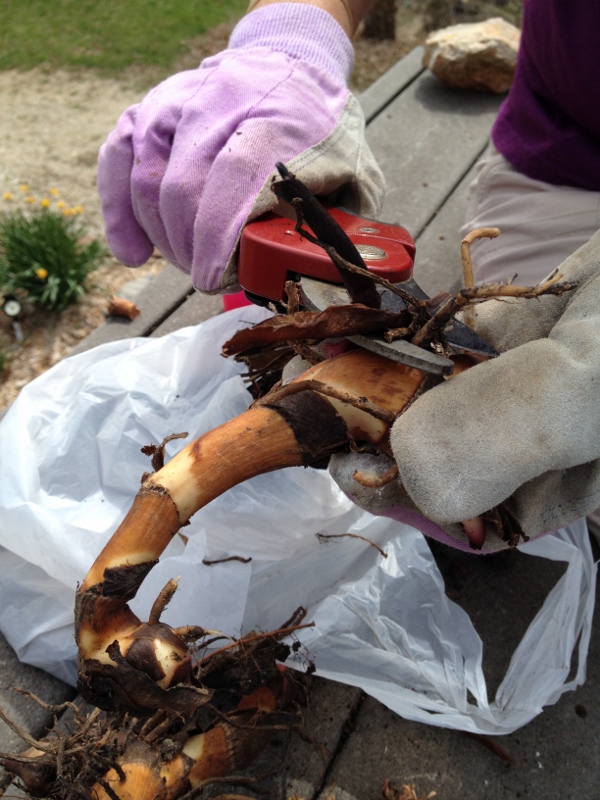
We then began to trim the dead roots off the bulb as well as any spongy, dead plant material so that we are left with a clean bulb for planting.

We trimmed off lots of spongy, dead material. The decayed stuff is easily identifiable because it is a dark and soft matter, as opposed to a healthy bulb which is firm and white.
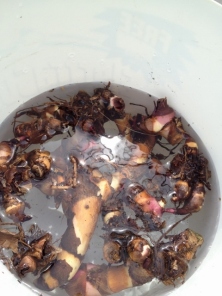
We soaked the bulbs in water to further clean them and re-hydrate them after a long winter in the basement.
4 Annuals I am Obsessed With
A benefit of surviving a hot, humid St. Louis summer is that sub-tropicals perform well here as annuals. My list below includes annuals I’m obsessed with that are common in the south, but also pack a punch here in the Midwest. Or maybe I’m obsessed with these selections because they are a throw-back to my early 20s, when I lived in Houston, TX, where I was able to admire these plants day in and day out. Either way, these plants bring up the garden energy a notch and provide a leave me with sense of joy long after their beauty has faded. Most on the list I plant each and every year; while Canna has yet to join the backyard annuals.
What annuals accent your garden?
Embed from Getty Images
Canna. No, St. Louis is not the tropics, although a sweltering July or August day will give zones 8-10 a good run for their money. I do not live in the right zone for this plant, so it is classified as an annual here, but, yes, I’ve got to have this plant. I promise to shelter it from harsh winds and give it the full sun it requires and I am confident this tall, handsome plant will return the favor with gorgeous foliage that climbs the length of its 8-ft height and an unfurling of vibrant, ruffled flowers.
Embed from Getty Images
Caladium. Arching gracefully above the other mix of annuals in my window boxes on the front of my house, caladiums provide a little bit of that extra curb appeal I’m looking for every summer. And they give me the height I am looking for…not too tall, but just enough to draw attention. Their variegated white/green/pink foliage provide a nice pop of color in the shade, and I adore their arrowhead shape. So pretty, you might forget they’re not a flower.
Mexican heather (cuphea hissopifolia). Some like it hot and this baby really performs when the sun beats down…as long as it receives a restorative drink of water each day. Looking for a plant that seems to be in constant bloom? Mexican heather is the perfect choice, as it always has small purple blooms among its glossy green leaves. I have incorporated this annual into my potting scheme for several years now and have never looked back. Typically I fill a pot with a variety of annuals for visual interest, but not with this one. She gets a pot all to herself.
Embed from Getty Images
Nicotiana (nicotiana sylvestris). Known as flowering tobacco (for the shape of its leaves, I suspect), I am a big fan of this guy. The bright, star-shaped blooms on this annual really know how to show off. And when daylight gives way to evening, nicotiana lets of a fragrant scent that’s sure to make you slow down and take notice. I have typically planted this in pots but this year I intend to give it a go in the garden bed to accent “Spruce Springsteen,” the name we have affectionately given the dwarf Colorado blue spruce that I planted a year ago. I gave Spruce lots of space to accommodate its girth, which won’t happen for a few more years. Nicotiana will be a nice way to fill up the mulch bed.
5 Plants I’m Obsessed With
Stealing a line from Bravo TV host and hometown son Andy Cohen, I am obsessed with these five plants for the garden:
Embed from Getty Images1. Tall garden phlox. The color range available and the lovely “eyes” of tall garden phlox make my heart skip a beat. These tall wonders are first on my list for an after-work garden stroll. They are fragrant and mingle delightfully among the Russian sage, bee balm and Stella de Oro daylily. While I enjoy them most in the garden, they hold up well in a cut arrangement gracing the dining table.
2. Hosta, “Dorothy Benedict”. This beauty seems to have it all. It looks like a painting with streaks of bright green-yellow, blue-green and green-green interspersed with white. Leaves are textured, edges are smooth. Pop it into the shade garden and gaze away. What’s not to love? Oh yeah, the price (I’ve seen Dorothy Benedict quoted at $200-$500).
3. Lady’s Mantle (Alchemilla mollis). Chartreuse-hued plants work well in a wide range of applications in the garden. Contrast this plant with cool blue-tinged foliage or the deep purples of “Mainacht” salvia. Or complement lady’s mantle with bursting colors such as bright pink Knockout roses. The old-fashioned girl will make its way into the garden this year.
4. Kobold Gayfeather (Liatris spicata). I like spikes, and this plant delivers. Commonly known as blazing star, it pushes forth a stalk that really is a bunch of rounded flower heads that are fun to watch unfold from the top down. It attracts butterflies and works well in clay soil. Kobold is a compact version of liatris, and I am told this plant does not need staking, another bonus.
Embed from Getty Images5. Foxglove (Digitalis). The tubular bells on this biennual are nothing short of amazing. The freckles on the inside if the bloom spill forward on these charming flower spikes will be the perfect addition to my cottage garden. I grew them years ago in my backyard garden in Palatine, IL. Why I haven’t introduced them to my St. Louis landscapes escapes me. But that’s about to change.

